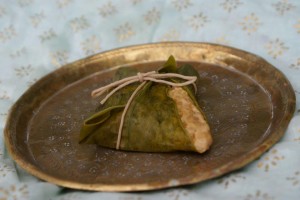A little while ago I wrote here of having grown ginger, tumicini and turmeric roots in my glasshouse among other similarly exotic things, as an experiment. I bought the roots from a Thai super market, very much inspired by a Thai grower I met last year who told me that as the British weather didn’t allow her to grow any useful quantity of the roots of ginger and turmeric, she grew and used them for their flavoured leaves instead.
It took mine an awful long time to get growing, so much so that they were semi-abandoned and left in that half-way-to-the-compost-heap zone near the greenhouse door. But just when I was on the verge of finally giving up on them one put forth a small green shoot, then another, and finally all followed suit. Success! Now, what to do with them…
 The fact that I couldn’t find any recipes suggesting eating them doesn’t mean it shouldn’t be done, but it has most probably contributed to them sitting on the greenhouse bench untouched a little longer than they should have. So long in fact that it is now time to tuck them away for winter. As I have run out of space on my heated mini greenhouse shelf I need to chop the leaves off to fit them in anyway. This has concentrated my mind on finding a use for the lopped leaves.
The fact that I couldn’t find any recipes suggesting eating them doesn’t mean it shouldn’t be done, but it has most probably contributed to them sitting on the greenhouse bench untouched a little longer than they should have. So long in fact that it is now time to tuck them away for winter. As I have run out of space on my heated mini greenhouse shelf I need to chop the leaves off to fit them in anyway. This has concentrated my mind on finding a use for the lopped leaves.
It seems that traditionally turmeric leaves are used to wrap and subtly infuse foods, rather than being eaten directly themselves. One of the most tempting uses for them I found is Patoleo, a Goan recipe involving several painstakingly long and unfamiliar processes. The basic ingredients though are rice, jaggery (raw palm sugar), cardamom and coconut, all wrapped up in a turmeric leaf and steamed. So I decided to make my own version by making a cardamom-spiced coconut milk rice pudding, and wrapping little parcels of it and banana in the turmeric leaves before steaming. Being low on jaggery I used soft dark brown sugar instead: as close as my baking cupboard could offer to sugar in that raw state. The rice pudding was pretty delicious once made, cosy and spicy, and I did wonder what the turmeric leaves would add, but I soldiered on regardless. I had been promised by various recipes that the smell of the steaming turmeric leaves alone was worth the trouble and those promises came good. A light, citrusy and surprisingly unspicy fragrance filled the kitchen. They added the same flavours to the parcels, giving a little sharp lift to all that cosyness.
I will hope the plant makes it through the winter, and starts producing these leaves a little earlier in the year and in greater abundance. I’ve seen other recipes using the leaves, including fish wraps, and I’d love to try them out. Turmeric leaves do add something a little special. For now, here’s this one:

- 80g pudding rice
- 3 tbsp soft dark brown sugar
- 400ml tin coconut milk
- 2 cardamom pods
- 4 turmeric leaves
- 1 banana (I’m also tempted to try this with a sliver of mango)
- You will also need a steamer and some string
Place the cardamom pods into a mortar and pestle and bash gently, then release the seeds, discard the outer casings and crush the seeds to a fine powder. Put the rice, sugar, cardamom and coconut milk into a saucepan and slowly bring to the boil, stirring all the time. Turn down low, cover with a lid, and simmer for about thirty minutes, stirring occasionally. When it is thick and creamy, remove it from the heat and leave it to cool a little.
Wipe the turmeric leaves with a damp cloth and place a spoonful of the rice mixture and a slice or two of banana in the centre. I am very obviously no expert on the next part, but you need to somehow tie this up with string. Littler leaves can just be sandwiched together, using the rice pudding as glue. Steam for 20 minutes, release the string, and eat hot.


